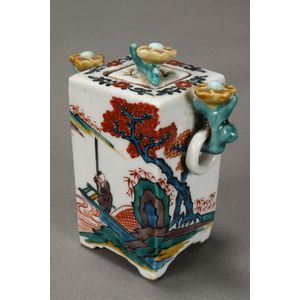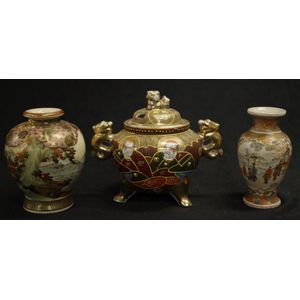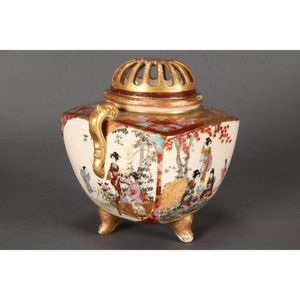
Meiji Satsuma Censor with Gilded Lion Dogs and Mt. Fuji
A Satsuma Meiji period censor. With gilded temple lion dogs in high relief, the lid with a lion dog finial. Painted in a continuous scene with bijin in a landscape with Mt Fiji in the background.

Meiji Kutani Vase, Plate, and Censor Set with Vase Fault
Japanese Meiji period Kutani vase and plate and lidded censor. The vase faulted.

Meiji Satsuma Censor with Figures and Lakeside Villages Panels
Fine Japanese Satsuma censor, Meiji period, signed to the base. Depicts panels of figures and lakeside villages.Height: 8.5 cm

Japanese Studio Celadon Censer by Suwa Sozan I, Meiji/Taisho Period
A Japanese studio celadon censer by Suwa Sozan I (1852-1922), Meiji (1868-1912) or Taisho period (1912-1926), of bombe form with tripod legs in the form of a classic Song Dynasty Longquan censer, with impressed oval mark to the base reading 'Sozan,…

Miyanaga Tozan I Celadon Censer: Paulownia Leaf and Flower
A Japanese studio celadon censer by Miyanaga Tozan I (1868-1941), Showa period (1926-1989), circa 1930s, Ingeniously modelled as a paulownia leaf and flower mon visible from three sides, the leaves forming the censer and the flowers forming the lid, the…

Japanese Satsuma Gilded Elephant Koro with Missing Cover
Japanese Satsuma elephant form koro, heavily gilded caparisoned elephant supporting censor on back. Signed. Koro cover missing. Height 24 cm, length 26 cm

Meiji Satsuma Censer with Gilt Lion Finial
Meiji period Japanese Satsuma lidded censer featuring gilt temple lion finial, height 12 cm

Satsuma Horseback Court Scene Censer
Good Satsuma censer and cover, with domed cover above a cylindrical body, decorated with a continuous scene of court figure on horseback, surrounded by attendants in landscape, four character mark to base, height 13 cm

Celadon Tripod Censer with Tomobako
A celadon-glazed tripod censer with tomobako, 8.4 cm diam., 5.9 cm high

Japanese Blue and White Censer by Takahashi Dohachi IV
A Japanese blue and white censer, by Takahashi Dohachi IV (1845-1897), Meiji period (1868-1912), the rectangular censer resting on four cabriole legs, decorated with landscape scenes to the front and rear, with shishi handles and finial to the lid. Marked…

Japanese Satsuma Gilt Censer with Foo Dog Handles
A Japanese Satsuma censer, late Meiji period, a large Japanese satsuma tripod censer, decorated in various coloured enamels and gilt on a crackled cream glaze with panel portraits bordered by geometric patterns, with gilded foo dog twin handles, feet and…

Satsuma Twin Handled Censor with Geisha Scene
Satsuma twin handled censor, of baluster form, with a scalloped lip, above baluster body, decorated with a scene of knelling geishas, flanked by kylin handles, a/f, height 32 cm

Satsuma Twin Handled Censer with Geisha and Floral Decorations
Good Satsuma twin handled censer and cover, of facetted form, decorated with reserves to each side displaying geishas and flowers, surrounded by a fine brocade border, in rich tones of blue, white and red, accented in gilt, makers marks to base, height 14…

Edo Period Japanese Porcelain Censer with Dutch Ship Design
A Japanese porcelain censer (Koro), Edo period, of square outline, painted with a Dutch ship and a group of Europeans in coloured enamels and gilt on short bracket feet, height 8 cm. Provenance: Strebel, Wiesbaden, Germany, acquired from the above circa…

Japanese Ko Kutani Twin Handled Censer with Continuous Scene
Good Japanese Ko Kutani porcelain twin handled censer and cover, of facetted form set with floral finials, with twin handles with drop rings, the body decorated with continuous scene depicting a man on a boat, with lake, trees and rocky outcrop, in tones…

Japanese Satsuma Immortal Censer with Pierced Cover
Large Japanese Satsuma censer and cover, with immortal finial above a pierced domed cover, decorated with reserves of flowers on a brocade ground, on a circular foot, in rich tones of gold, green, red and blue, a/f, height 35 cm

Meiji Satsuma Censer with Tea Ceremony Scene
Stunning Satsuma Meiji period censer, of squat globular form with an inverted rim, the body beautifully decorated with frieze of forty six seated ladies in a tea ceremony with screens and vases, below a rim decorated with intricate border of melons, wings…

Hand-painted Satsuma ceramic censer with pierced lid
Satsuma Japan hand painted ceramic censer hand painted figures in a garden decorated, on cobalt blue ground, pierced lid, restored, red character mark to base, height 13 cm.

Satsuma Hand Painted Lidded Censer with Traditional Scenes
Good Satsuma Japan hand painted lidded censer censer type vessel, hand painted figures in traditional scenes, pierced and gilded lid, dual handles, black character mark to base, height 8 cm.

Satsuma Japan Ceramic Trio
Three Satsuma Japan ceramic pieces including posy vase, with hand painted traditional scenes, character mark to base, height 10 cm, another hand painted posy vase, depicting traditional scenes, height 9.5 cm, and a Japanese ceramic censer, decorated with…

Japanese Satsuma Hand Painted Censer and Bowl
Two Japanese Satsuma hand painted pieces including lidded censer, height 7 cm, and a bowl with figures in a garden decoration, diameter 9.5 cm, each with hand painted decoration, on cobalt blue ground, bowl with red character mark to base.

Satsuma Koro with Lion Head Handles and Shi Shi Cover
A fine Satsuma Koro, late Edo/ Meiji period, 1860-70, mark of Dai Nippon (great Japan), signature, the censer with lion head ring handles and fantastic creature tripod feet, a well modelled shi shi lion dog to the cover, decorated to the body with four…

Meiji Satsuma Koro with Kannon and Rakan Decoration
A large export ware Satsuma Koro, Meiji period, 1868-1912, red hiragana characters and shimazu family crest, of typical censer profile with an ovoid body, a moulded tripod base, applied, shi shi dogs to the collar and surmounted by a pierced domed lid…

Late 19th Century Satsuma Censer & Cover, 17cm
Late 19th century Satsuma censer and cover, all finely decorated in the traditional manner with seal mark to base, 17 cm height

Large Japanese Arita Koro with Guardian Lions, Meiji Period
A large Japanese Arita Koro, Meiji period (1868-1912), the exceptionally large censer with a high pierced foot, twin handles and a pierced cover surmounted by two playing guardian lions, the whole decorated in polychrome enamels, with two shaped reserves…

Satsuma Twin Handled Censer with Dragon Handles and Brocade Work
Satsuma twin handled censer and cover, with a domed pierced cover, above a facetted baluster body, with brocade work to shoulders and panels of figures, flanked by dragon handles on four feet,a/f, height 16.5 cm

Kutani Immortal Censer Figure
Kutani porcelain figure, depicting an immortal seated with robes falling from head, holding a censer in hands, on rocky outcrop, in tones of white, green, black and red, height 25 cm

Satsuma Twin Handled Censer with Immortal Decoration
Good Satsuma twin handled censer and cover, of facetted form, with a pierced handle, decorated with immortals in rich tones of gilt, red and black, flanked by kylin handles, raised on four feet, character mark to base, height 17 cm

Satsuma Twin Handle Lidded Censer with Po Dogs and Figures
Satsuma twin handle lidded censer (H 32 cm) with three dogs of Po adorning the lid and acting as handles and decorated with Japanese men surrounding possibly and empress to centre, sitting on gilt lion feet, height 34 cm

Satsuma earthenware censer by Fujisan, Meiji period
A Satsuma earthenware censer and cover by Fujisan, Meiji period, on tripod feet, painted in colours and gilding with medallions of figures reserved on a ground of flowering plants, the pierced cover of radiating gilt petals encircled on the narrow…

Satsuma Twin Handled Censer with Kylin Finial
Large Satsuma twin handled censer and cover, of baluster form, with kylin finial, above a body decorated with figures and brocade in tones of red, gilt and blue, on three feet, height 42 cm

Japanese Satsuma Censer with Flower Decoration
Japanese Satsuma censer and cover, of baluster form, decorated with flowers, in tones of pink, red and green on three feet, seal mark to base, height 13 cm

Japanese Satsuma Censer with Gilt Accents and Cover
Fine Japanese Satsuma censer and cover, of facetted form, decorated with panels depicting birds, brocade, fish and figures, accented in gilt, on multiple feet, with gilt metal cover, signed to base, height 9 cm

Japanese Satsuma Hand-Painted Lidded Censer with Character Marks
Rare Japanese Satsuma lidded censer, hand painted decoration (some wear), pierced metal cover, tri footed. Character marks to base. On wood stand. Height 10 cm (censer only).

Kutani Lady with Censer on Rock
Kutani figure of a lady modelled holding an censer, seated upon a rock. Condition: good, minor wear to the base, height 26 cm

Large Satsuma Censer with Warriors and Foliage
Late 19th century large Satsuma censer and cover ovoid body on raised on three scroll legs painted with warrioes and foliage (damage to temple dog cover finial) 51 cm height

Japanese Satsuma Censer with Lion Dog Handle
A Japanese Satsuma censer, with raised enamel & gilt on crackle glaze body, a lion dog handle to lid and clear mark to base, height 23 cm

Geisha Satsuma Censer with Foo Dog Finial
Satsuma censer finely painted showing geisha in a rural pagoda scene, standing on a tripod base & having a foo dog finial. Stamped with a four character signature to the base. Condition good, minor age related wear. Height 15 cm

Japanese Imari Porcelain Vase with Hunting Eagle and Exotic Birds
A fine Japanese porcelain large vase, decorated in panels, one with a hunting eagle, the other with exotic birds, the panels reserved on a background decorated with Madoe panels in Imari pallet. Shouldered ovoid shape, marked under the foot with a censer…

Satsuma Censer with Holy Men and Samurai Decoration
Satsuma two handled censer decorated with holy men & samurai with a Komainu finial. Condition fair, chip to the lid & restoration to one handle. Height 14 cm

19th Century Satsuma Warrior & Scholar Censer (Damaged)
Late 19th century Satsuma censer and cover finely decorated with panels of warriors & scholars (some damage)

Satsuma Buddhist Censer with Lion Mask Handles and Foo Dog Finial
A Satsuma earthenware Koro censer and cover, ovoid shape raised on three feet, decorated in relief and enamels with Buddhist figures, lion mask and ring handles issue from the sides, the lid surmounted by a foo dog finial, all highlighted with gilding.…

Japanese Satsuma Tripod Censer, Signed - 31cm Width
Large Japanese Satsuma tripod censer, signed. Width 31 cm

Satsuma Chrysanthemum Censer with Dog Finial, Signed
Satsuma tri footed censer with dog of fo finial & heavily decorated with chrysanthemums, signed to base. Height 22 cm

Meizan Satsuma Censer with Birds and Flowers
Superb Japanese Satsuma lidded koro (censer), signed Yabu Meizan, Meiji period (1868-1912), the body very finely enamelled and gilt with eight panels of birds, figures and sea landscapes, the lid with ?the thousand flowers? design. Width 12.5 cm

Satsuma Sake Censer with Quail Finial
Japanese Satsuma censer, in form of a saki container; quail finial to lid. Height 8 cm

 Loading more...
Loading more...